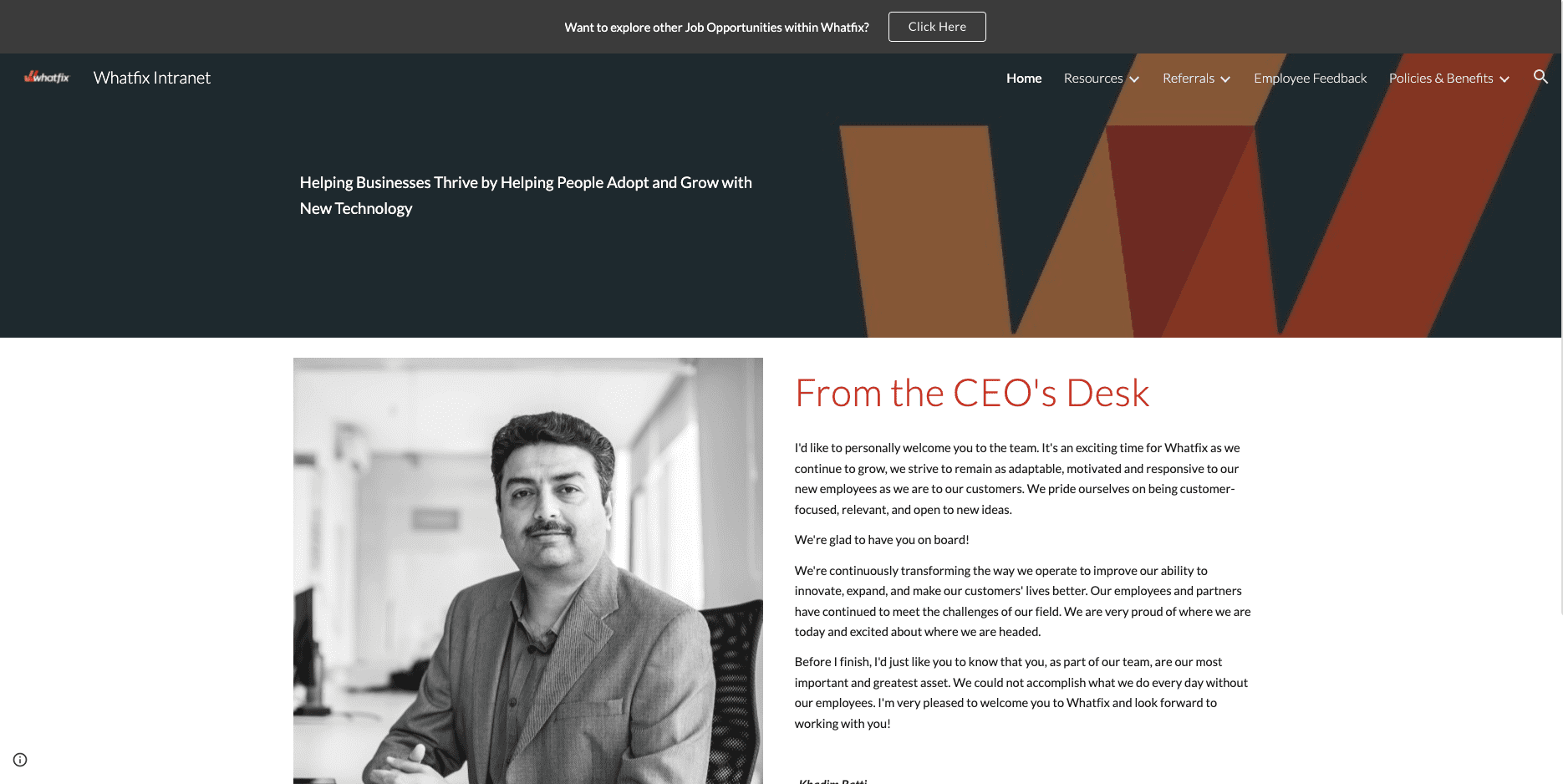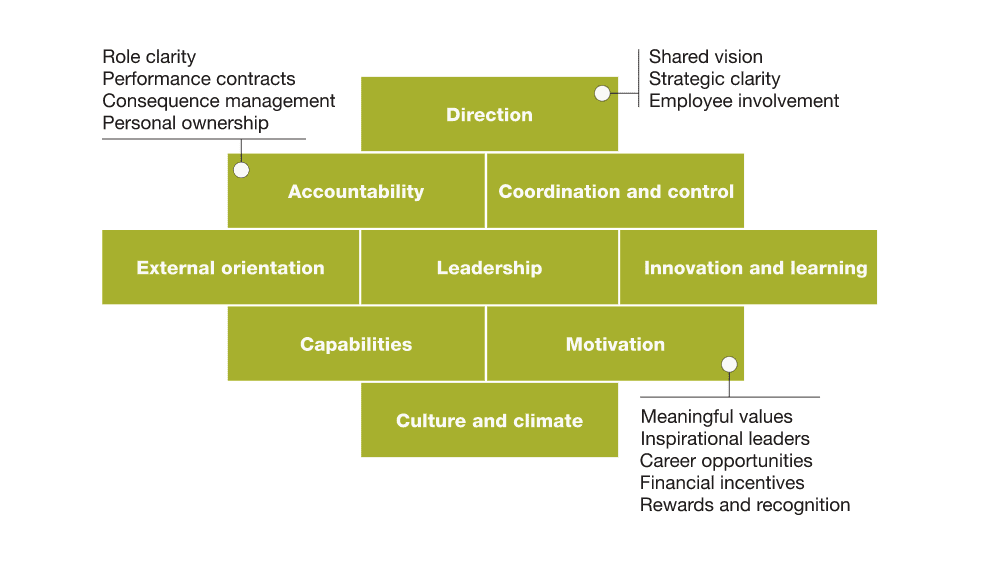What Is Organizational Health? 6 Pillars of a Healthy Organization (2024)


It turns out it’s not enough to find product/market fit to build a successful business.
A profitable company isn’t built upon short-term performance goals. It takes a long-term strategy and people who can execute it. In other words, it takes a healthy organization.
McKinsey has been monitoring the health of more than 1,500 companies across 100 countries for 10 years. They’ve been aggregating views of employees and managers on actions taken to improve organizational health and have found out these activities correspond with enhanced financial performance.
Its research has shown that companies working on their company’s health not only achieve improvements in their organizational well-being but also demonstrate tangible performance growth in 6 to 12 months – as well as set up organizations to more successfully manage digital transformation efforts.
What Is Organizational Health?
Organizational health determines a company’s ability to develop, communicate, and follow a common business strategy by maintaining a highly engaged workforce.
Organizational health is not only how your teams work towards a common goal, but also how they can cope with organizational change. It’s all about happy, proactive employees that are ready for innovation.
6 Pillars of a Healthy Organization
Organizational health is composed of various psychological, physiological, and social components. There’s no ‘secret sauce’ allowing to maintain a perfectly healthy organization.
Nonetheless, here are five key factors that positively affect organizational health.
1. Organizational alignment
Organizational alignment ensures all employees have a shared vision of the company’s goals, values, and strategy.
When the topic of organizational alignment is brought up, sales and marketing alignment is the first to come to our minds. However, the subject of organizational alignment relates to each and every department, including finance, IT, human resources, customer support, etc.
Organizational alignment is achieved through consistent effort. While each team member might clearly understand their smart goals and career development plan, it’s critical that you transmit a bigger picture explaining how their successes correlate with the success of the entire organization.
One of the strategies used to achieve organizational alignment is creating a documented single source of truth, which typically takes the form of a knowledge base. This resource will support transparency and allow employees across different departments to be on the same page.
Below you can see our intranet portal here at Whatfix that is a centralized hub for all things Whatfix.

Alignment is composed of the following aspects:
- Cross-departmental collaboration
- Shared goals and objectives
- The vision of the ultimate goal (i.e. company mission)
- Organizational performance and individual performance goals linked to the business strategy
- A clear understanding of each others’ roles
Without a doubt, organizational alignment results in many benefits, such as improved employee relationships, employee loyalty, and a unified workforce working towards the same goals – put together, they lay the foundation for a healthy organization.
2. Clearly communicated processes & workflows
Organizational alignment cannot be achieved without effective communication.
Regardless of the niche, people managers are trying hard to maintain clear, transparent communication within organizations.
Remote work has taken the reigns, and communication management has become a serious problem for distributed organizations. 33% of employees say communication has become more of a challenge with the shift to remote working.
At non-tech companies, management struggles to combat poor communication among deskbound and frontline workers.
It’s clear that effective communication is a luxury very few companies brag about. What does it mean for organizational health?
35% of businesses see increased employee turnover as a result of poor internal communication. A healthy organization addresses the problem by creating comprehensive policies that regulate communication between employees, stakeholders, and the entire community.
3. Employee wellbeing & development
Employee wellbeing is critical for organizational health.
To maintain a healthy organization, people managers should shift their focus from financial incentives to employee wellbeing. Workplace wellbeing depends on many aspects, such as the mental state of employees, workplace safety, physical health, social connections, and work attitude.
In 2021, 88% of employers were investing more in mental health support at organizations. Many of them have expanded paid leave policies, subsidized home office setup, and expanded virtual employee engagement activities.
Workforce priorities are changing – employees expect their organizations to support them in balancing work and personal life. Work-life balance has become another critical aspect of employee wellbeing. You can achieve it by offering flexible working hours, focusing on productivity rather than hours, and encouraging employees to utilize vacation time.
Employee development is one more important component of organizational health and is closely related to wellbeing. Without professional growth, staff doesn’t feel empowered to improve their skills and eventually gets burned out by performing monotonous tasks.
To support employee development, organizations need to develop a career development plan for each hire and introduce professional training programs. It’s smart to also encourage soft skills development and continuous employee upskilling.
4. Organizational fairness
Organizational fairness, or organizational justice, determines the perception of employees of how fair they’re treated in the workplace. The concept affects the workforce’s attitude to the work they do.
Gender equality, inclusion, gender equality, wages, and career development are the key factors affecting employees’ perception of fairness in the organizational context.
From the employer’s standpoint, organizational fairness is most difficult to control or measure. You can’t affect your staff’s feelings. All you can do is to implement transparent workplace procedures, including:
- straightforward assessment techniques
- written career development paths
- open decision-making framework
- inclusive benefits plan
By implementing these procedures, you’ll improve the perception of organizational justice at your company and create a positive, healthy work environment.
5. Meaningful work
Before we explain how meaningful workplaces drive organizational health, let’s figure out what meaning at work is.
Meaningful work is work that creates a sense of purpose and value in an employee’s daily routine. It’s what gives your workforce the courage to take on challenging, unpopular tasks and complete them.
As we’ve already said, money can’t be the only motivator that makes people deliver their best effort. And since a healthy organization is always driven by proactive employees, it’s impossible to build one without giving your staff a purpose.
6. Innovation
Organizational health isn’t all about employee engagement. The ability for digital innovation has recently become a very important issue for organizations all over the world. In a fast-changing market, only companies that have the energy for change can take the lead.
Creative thinking, cognitive flexibility, and idea-sharing are the three pillars your company’s ability to innovate stands on. Each of them is also a distinguishing feature of healthy company culture.
These are the main elements that foster creative thinking and innovation:
- tolerance for failure;
- active listening;
- reduction of organizational bureaucracy;
- flexible leadership.
When all these elements are balanced, a workplace becomes both comfortable and challenging.
Five Frames of Organizational Health
There’s no convenient guide on building a healthy organization. However, there’s a framework that acts as a strategic roadmap for companies of all sizes and niches.
The “5As” framework was introduced a decade ago to help businesses structure their journey towards strong organizational health:
- Aspire: Where do we want to go? Determine what the ‘healthy organization’ concept means to you.
- Assess: How ready are we to go there? You’ve set a goal, but now is the time to figure out whether your organization has the capacity to achieve it.
- Architect: What do we need to do to get there? This is where you outline the steps towards a healthier work environment.
- Act: How do we manage the journey? Organize initiatives into a clear structure: involve leaders, make sure everyone involved understands what’s happening and why you need it, and decide on how you’re going to keep track of the progress.
- Advance: How do we keep moving forward? When you have the infrastructure for continuous improvement, think of how to encourage leaders to drive continuous improvement.
Now that you’ve got a view of each stage of the upcoming journey, you can get a firm grip on your organizational health.
How to Measure Organizational Health
The concept of organizational health is vague. Creating a system where you can measure it brings more clarity into the overall health of your organization and the benefits and success your organizational health initiatives have.
McKinsey has introduced its Organizational Health Index (OHI) as a way to measure an organization’s effectiveness based on organization-wide surveys. OHI takes into account a variety of factors, such as:
- Direction
- Accountability
- Coordination and control
- External orientation
- Leadership
- Innovation and learning
- Capabilities
- Motivation
- Culture and climate

Despite the fact McKinsey’s questionnaire isn’t available on the web, this is a great basis for organizational health surveys. For each element, create several questions and offer a 1-to-10 scale for employees to rate each aspect affecting your organizational health.
However, measuring organizational health is only effective when you have a benchmark to compare against. For instance, you could run different surveys for employees and leaders to see how their opinions align.
People at different levels of hierarchy often have different perceptions of each of the nine factors listed above. By capturing these discrepancies, you’ll identify the areas that need specific attention.

How to Improve Your Organization's Health
Finally, you know what makes organizational health and how to assess yours. Let’s move on to actionable steps towards improving your organization’s health.
1. Create a Cohesive, Strong Leadership Team
The first step towards building a healthier organization is to actively involve your leadership team. Managers should participate in each stage of the journey – from strategic planning to execution and tracking.
Leaders account for at least 70% of fluctuations in employee engagement scores, and for good reason. Great managers set the tone for entire teams, motivate top performers, and identify workplace issues early.
To create a strong leadership team, start by implementing the following initiatives:
- Communicate your vision. Managers should help to transmit your company vision to employees – to do it, they need to be truly integrated into the culture.
- Run yearly strategic planning meetings. Typically, these sessions take no less than two full days and are followed by team-building activities that strengthen bonds among leaders.
- Help your leaders to encourage autonomy in the workplace. Micromanagement puts your organization’s health at threat.
2. Be Clear in Your Mission
When seeking productivity and performance, companies still underestimate the importance of the mission. However, building a healthy organization isn’t possible without a clearly defined mission statement.
Today, nine in ten adults believe it is important for an organization to have a clear mission and purpose.
A mission statement is an articulated company’s purpose. It’s the “why” behind every action you take.
To write a mission statement that resonates, you need to be specific and avoid vague words. The statement should determine the company’s direction as well as the ultimate goal.
3. Overcommunicate
When done right, over-communication is a great way to avoid negative perceptions of organizational fairness.
Overcommunication allows leaders to transmit important messages and be heard. Employees, on their end, know what’s expected from them and have all the necessary directives to deliver tasks effectively.
But how is it achieved?
First of all, you need to give your teams the right tools. A company should have a centralized communication channel where all the discussions, ideas, and agendas are stored.
A common problem of companies using email as their prime messaging channel is the need to include everyone involved in the copy – if someone is missed, communication is failed.
Ideally, you need to have all your internal processes documented. Creating a knowledge base or internal wiki will be a perfect solution allowing everyone at your organization access and contribute information needed to perform their best work.
Frequent but quick check-ins also help to create a culture where employees are accountable but not overwhelmed by drawn-out meetings with vast agendas.
4. Reinforce Your Mission
It’s important not only to develop and document the company’s core values but also to share them in a way that encourages employees to follow them. You can connect your employees to your company’s mission only by living it.
For instance, our mission statement at Whatfix is, “helping businesses thrive by helping people adapt and grow with new technology,” and the best way to root it is by making sure our own employees don’t face issues with digital adoption.
If you have already made effort to transmit an organizational mission, it’s worth measuring the adoption. Together with the leadership team, discuss the following questions:
- Communicate your vision. Managers should help to transmit your company vision to employees – to do it, they need to be truly integrated into the culture.
- Run yearly strategic planning meetings. Typically, these sessions take no less than two full days and are followed by team-building activities that strengthen bonds among leaders.
- Help your leaders to encourage autonomy in the workplace. Micromanagement puts your organization’s health at threat.
When you are able to answer these questions, you’re on the right path towards building a healthy organization.
Request a demo to see how Whatfix empowers organizations to improve end-user adoption and provide on-demand customer support


